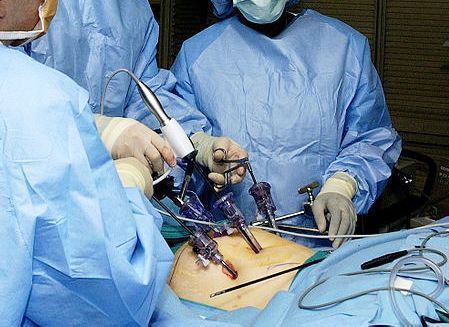Microinvasive surgery at the service of women, a forefront Hospital
Hospital Santorso at the avant -garde reality: innovative techniques offer numerous clinical advantages and greater sustainability.
In six years reduction of interventions in laparotomy from 22 to 3% in favor of Mininvasive surgery.
At Santorso, today, a study day on minimally invasive surgery in gynecology.
The obstetrics and gynecology department ofSantorso Hospital began in 2010 a path to guarantee the most innovative and safe techniques and procedures to its patients. «Considered on the agenda, explains Marcello Scollo, director of the maternal department – Infantile, advanced laparoscopic surgery interventions are normally performed only in centers of national surgical excellence. For some time, however, they have been a reality at the Santorso Hospital and this result has been possible thanks to the constant updating of our doctors and at the high level assistance activities of all the ward and operating room staff. With this in mind, today the course “Microinvasive surgery Santorso’s way” will be held, an opportunity to discuss, together with surgeons from other structures in the Veneto Region, minimally invasive techniques in gynecology, evaluating their clinical merits and repercussions in terms of sustainability economic».
There Mininvasive surgery It is still not widespread in Italy, despite their advantages, especially for patients are increasingly recognized. «For patients, says Carlo Dorizzi, referent operating room of gynecology, the benefits are countless and represented by a more Fast recovery, A lower time of stay in the hospital and a better clinical result with less complications, thanks to the safety and precision that these techniques guarantee and the need for less use of drugs to counter pain. Mininvasive surgery is called “gentle” as it reduces the impact on healthy and close tissues and organs and, in 70% of cases, considering even the more complex ones, it does not make it necessary to use analgesic drugs to reduce post- operating. Most of the patients get out of bed and drink after only 6 hours from the intervention and generally is discharged the next day ».
In gynecology, one of the most frequent surgical interventions is the hysterectomy, i.e. the removal of the uterus. «If we consider this type of intervention, continues Valentina Bresciani, gynecologist at the Santorso hospital, the use of laparoscopy in our department has gone from 41% to 86% of cases in six years, with a consequent reduction in traditional laparotomic procedures from 22 to 3%. The Santorso hospital presents a peri-operative management, called “fast track”, which responds to the same principles of minimally invasive surgical techniques: minimize hospitalization, reduce the patient’s pre-operative preparation, early discharge and immediate return to lead a normal life. For example, the organizational and assistance effort led to a reduction of almost 2 days, from 4 to 2.3, average hospitalization days for laparoscopic hysterectomy».
«One of the causes of removal of the uterus, explains Sara Fantinato, referent of gynecological oncology, are the tumors. In our structure, a patient with uterine cancer is operated on and discharged within 30 days of diagnosis. In these cases, the hospitalization lasts about 2 days and the patient is discharged in good condition and with all the checks, already foreseen and planned, by an ’ multidisciplinary team of doctors formed and dedicated to this.
The minimally invasive techniques also represent an advantage for the lower “personal” costs, the absence of pains and scars with a minimum physical impact, family and social since a return to work and life faster is possible “.
«In addition to the enormous advantages for the patient, clarifies Marcello Scollo, minimally invasive techniques represent an opportunity also for the sustainability of our national health system, a hot topic in recent times. If we go to monetize the savings that derive from the adoption of these surgical practices, the reduction of hospitalization days, use of analgesic drugs and antibiotics, these become very important and, in the experience of our hospital, have reached more than 300.000 euros in three years».


